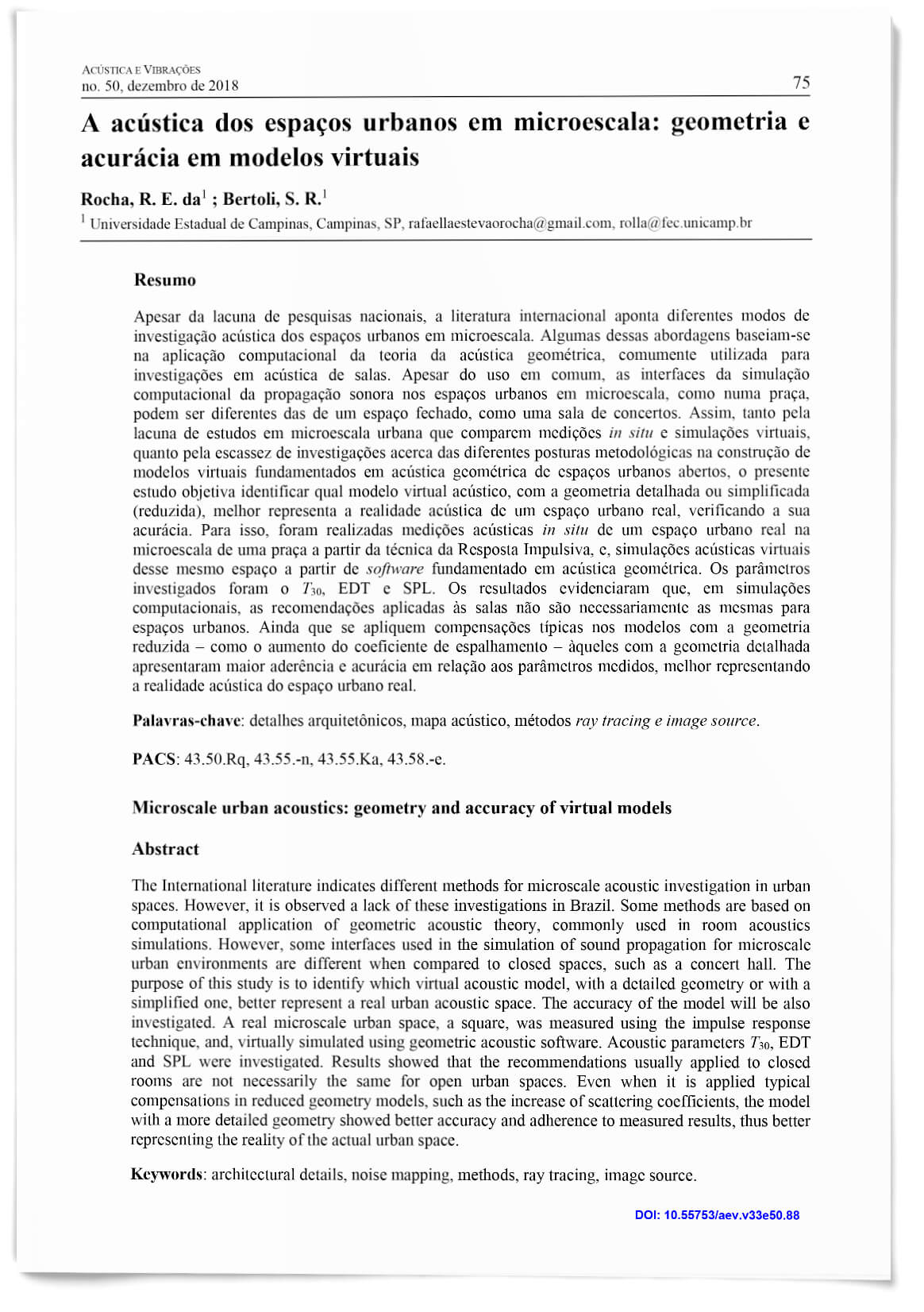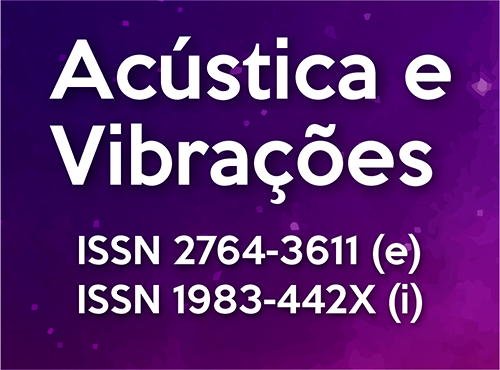Microscale urban acoustics: geometry and accuracy of virtual models
DOI:
https://doi.org/10.55753/aev.v33e50.88Keywords:
architectural details, noise mapping, methods, ray tracing, image sourceAbstract
The International literature indicates different methods for microscale acoustic investigation in urban spaces. However, it is observed a lack of these investigations in Brazil. Some methods are based on computational application of geometric acoustic theory, commonly used in room acoustics simulations. However, some interfaces used in the simulation of sound propagation for microscale urban environments are different when compared to closed spaces, such as a concert hall. The purpose of this study is to identify which virtual acoustic model, with a detailed geometry or with a simplified one, better represent a real urban acoustic space. The accuracy of the model will be also investigated. A real microscale urban space, a square, was measured using the impulse response technique, and, virtually simulated using geometric acoustic software. Acoustic parameters T30, EDT and SPL were investigated. Results showed that the recommendations usually applied to closed rooms are not necessarily the same for open urban spaces. Even when it is applied typical compensations in reduced geometry models, such as the increase of scattering coefficients, the model with a more detailed geometry showed better accuracy and adherence to measured results, thus better representing the reality of the actual urban space.
References
KANG, J. Sound Propagation in Interconnected Urban Streets: A Parametric Study. Environment and Planning B: Planning and Design, v. 28, n. 2, p. 281–294, 2001. doi: 10.1068%2Fb2680 DOI: https://doi.org/10.1068/b2680
KANG, J. Urban sound environment. London: Taylor & Francis, 2007. doi: 10.1201/9781482265613 DOI: https://doi.org/10.1201/9781482265613
KANG, J.; MENG, Y.; BROWN, G. J. Sound propagation in micro-scale urban areas: simulation and animation. In: Euronoise, Nápoles, Itália: 2003.
ATTENBOROUGH, K.; LI, K.; HOROSHENKOV, K. Predicting outdoor sound. London: Taylor & Francis, 2007. doi: 10.1201/9781482295023 DOI: https://doi.org/10.1201/9781482295023
PROBST, W. Uncertainty and quality assurance in simulation software. In: Noise mapping in the EU models and procedures. Boca Raton: CRC Press, Taylor & Francis Group, 2013. doi: 10.1201/b12885 DOI: https://doi.org/10.1201/b12885
LYON, R. H. Role of multiple reflections and reverberation in urban noise propagation. The Journal of the Acoustical Society of America, v. 55, n. 3, p. 493–503, 1974. doi: 10.1121/1.1914527 DOI: https://doi.org/10.1121/1.1914527
DAVIES, H. G. Multiple‐reflection diffuse‐scattering model for noise propagation in streets. The Journal of the Acoustical Society of America, v. 64, n. 2, p. 517–521, 1978. doi: 10.1121/1.382002 DOI: https://doi.org/10.1121/1.382002
PICAUT, J.; SIMON, L. A scale model experiment for the study of sound propagation in urban areas. Applied Acoustics, v. 62, n. 3, p. 327–340, 2001. doi: 10.1016/S0003-682X(00)00028-1 DOI: https://doi.org/10.1016/S0003-682X(00)00028-1
KANG, J. Numerical modelling of the sound fields in urban streets with diffusely reflecting boundaries. Journal of Sound and Vibration, v. 258, n. 5, p. 793–813, 2002. doi: 10.1006/jsvi.2002.5150 DOI: https://doi.org/10.1006/jsvi.2002.5150
ONAGA, H.; RINDEL, J. H. Acoustic characteristics of urban streets in relation to scattering caused by building facades. Applied Acoustics, v. 68, n. 3, p. 310–325, 20075. doi: 10.1016/j.apacoust.2006.01.010 DOI: https://doi.org/10.1016/j.apacoust.2006.01.010
CAN, A.; FORTIN, N.; PICAUT, J. Accounting for the effect of diffuse reflections and fittings within street canyons, on the sound propagation predicted by ray tracing codes. Applied Acoustics, v. 96, p. 83–93, 2015. doi: 10.1016/j.apacoust.2015.03.013 DOI: https://doi.org/10.1016/j.apacoust.2015.03.013
EUROPEAN COMISSION. Good practice guide for strategic noise mapping and the production of associated data on noise exposure. WG-AEN. Versão 2. Versão final. 13 jan. 2006.
ROCHA, R. E. da; BERTOLI, S. R.; MAIORINO, A. V. Environmental noise performance: the detail of the building shape influence. In: Internoise, San Francisco, CA, USA: 2015. Disponível em: https://www.ingentaconnect.com/content/ince/incecp/2015/00000250/00000003/art00016
FASTL, H.; ZWICKER, E. Psychoacoustics: facts and models. 3. ed. Berlin; New York: Springer, 2007. DOI: https://doi.org/10.1007/978-3-540-68888-4
LICITRA, G.; MEMOLI, G. Limits and advantages of Good Practice Guide to noise mapping. In: Acoustic’08 Paris. Paris: 2008. DOI: https://doi.org/10.1121/1.2932687
KLÆBOE, R.; ENGELIEN, E.; STEINNES, M. Context Sensitive Noise Impact Mapping. Applied Acoustics, v. 67, n. 7, p. 620–642, jul. 2006. doi: 10.1016/j.apacoust.2005.12.002 DOI: https://doi.org/10.1016/j.apacoust.2005.12.002
ROCHA, R. E. da; BERTOLI, S. R. A acústica urbana e suas escalas de investigação. Acústica e Vibrações, v. 1, n. 48, p. 29–44, 2016.
TSAI, K.-T.; LIN, M.-D.; CHEN, Y.-H. Noise Mapping in Urban Environments: A Taiwan Study. Applied Acoustics, v. 70, n. 7, p. 964–972, 2008. doi: 10.1016/j.apacoust.2008.11.001 DOI: https://doi.org/10.1016/j.apacoust.2008.11.001
HORNIKX, M. Ten questions concerning computational urban acoustics. Building and Environment, p. 1–13, 2016. doi: 10.1016/j.buildenv.2016.06.028 DOI: https://doi.org/10.1016/j.buildenv.2016.06.028
HOWARTH, M. J.; LAM, Y. W. An assessment of the accuracy of a hybrid room acoustics model with surface diffusion facility. Applied Acoustics, v. 60, n. 2, p. 237–251, 2000. doi: 10.1016/S0003-682X(99)00059-6 DOI: https://doi.org/10.1016/S0003-682X(99)00059-6
KUTTRUFF, H. Room acoustics. 5. ed. Boca Raton: CRC Press, 2009. doi: 10.1201/9781482266450 DOI: https://doi.org/10.1201/9781482266450
CHRISTENSEN, C. L.; KOUTSOURIS, G.; GIL, J. ODEON room acoustics software version 13: user’s manual. Denmark: ODEON S/A, Scion DTU, 2016.
BORK, I. A comparison of room simulation software - the 2nd Round Robin on room acoustical computer simulation. Acta Acustica united with Acustica, v. 86, n. 6, p. 943–956, 2000.
BORK, I. Report on the 3rd Round Robin on Room Acoustical Computer Simulation – Part I: Measurements. Acta Acustica united with Acustica, v. 91, n. 4, p. 740–752, 1 jul. 2005.
VORLÄNDER, M. Internacional Round Robin on room acoustical computer simulations. In: ICA, Trondheim, Noruega: 1995.
ROCHA, R. E. da; BERTOLI, S. R. Outros olhares para o espaço urbano em microescala: uma revisão narrativa de simulações virtuais fundamentadas em acústica geométrica. In: XXVIII Encontro da SOBRAC, Porto Alegre, RS: 2018. doi: 10.17648/sobrac-87030 DOI: https://doi.org/10.17648/sobrac-87030
ROCHA, R. E. da; BERTOLI, S. R.; MAIORINO, A. V. Reducing geometry or detailing? Comparison between measured and modeled microscale urban spaces. POMA/ASA, v. 28, n. 015011, 2017. doi: 10.1121/2.0000391 DOI: https://doi.org/10.1121/2.0000391
ROCHA, R. E. da; MAIORINO, A. V.; BERTOLI, S. R. Accuracy of computer simulation software using hybrid models for microscale urban environments. POMA/ASA v. 28, n. 015012, 2017. doi: 10.1121/2.0000412 DOI: https://doi.org/10.1121/2.0000412
EL DIEN HH, WOLOSZYN P. The acoustical influence of balcony depth and parapet form: experiments and simulations. Applied Acoustics. v. 66, n.2, p.533–51, 2005. doi: 10.1016/j.apacoust.2004.09.004 DOI: https://doi.org/10.1016/j.apacoust.2004.09.004
MORI J, YOSHINO D, SATOH F, TACHIBANA H. Prediction of outdoor sound propagation by applying geometrical sound simulation technique. In: Internoise. Osaka, Japão:2011
MORI J, SATOH F, YOKOYAMA S, TACHIBANA H. Prediction of outdoor sound propagation by geometrical computer modeling. Acoustical Science and Technology. v.35, n.1,p.50-54, 2014. doi: 10.1250/ast.35.50 DOI: https://doi.org/10.1250/ast.35.50
PAINI D, GADE AC, RINDEL JH. Agorá acoustics - Effects of arcades on the acoustics of public squares. In: Forum Acoustics, p. 1813–8. Budapeste, Hungria; 2005.
MORI J, YOSHINO D, SATOH F, TACHIBANA H. Prediction of outdoor sound propagation by applying geometrical sound simulation technique. In: Internoise, p. 3079–83. Osaka, Japão: 2011.
BORK, I. A comparison of room simulation software - the 2nd Round Robin on room acoustical computer simulation. Acta Acustica united with Acustica, v. 86, n. 6, p. 943–956, 2000.
LISA, M.; HOLGER RINDEL, J.; CHRISTENSEN, C. L. Predicting the acoustics of ancient open-air theatres: the importance of calculation methods and geometrical details. In: BNAM, Mariehamn, Finlândia. Anais... In: BNAM. Mariehamn, Finlândia: 2004. Disponível em: https://citeseerx.ist.psu.edu/viewdoc/summary?doi=10.1.1.488.8560
KANG, J. Sound propagation in street canyons: Comparison between diffusely and geometrically reflecting boundaries. The Journal of the Acoustical Society of America, v. 107, n. 3, p. 1394–1404, 2000. doi: 10.1121/1.428580 DOI: https://doi.org/10.1121/1.428580
MENG, Y.; KANG, J. Combined ray-tracing and radiosity simulation for urban open spaces. In: ICA, Madri, Espanha. Anais... In: ICA. Madri, Espanha: 2007.
PICAUT et al. Experimental study of sound propagation in a street. Applied Acoustics, Urban AcousticsUrban Acoustics. v. 66, n. 2, p. 149–173, 2005. doi: 10.1016/j.apacoust.2004.07.014 DOI: https://doi.org/10.1016/j.apacoust.2004.07.014

Downloads
Published
How to Cite
Issue
Section
License
Copyright (c) 2018 Acústica e Vibrações

This work is licensed under a Creative Commons Attribution-NonCommercial-ShareAlike 4.0 International License.




